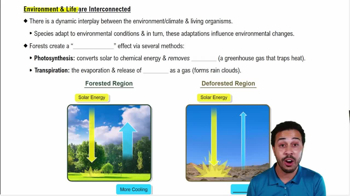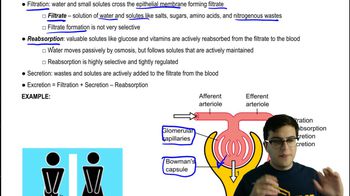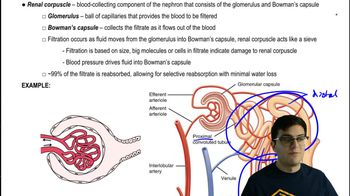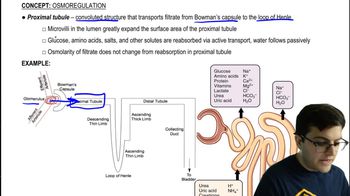Table of contents
- 1. Introduction to Biology2h 40m
- 2. Chemistry3h 40m
- 3. Water1h 26m
- 4. Biomolecules2h 23m
- 5. Cell Components2h 26m
- 6. The Membrane2h 31m
- 7. Energy and Metabolism2h 0m
- 8. Respiration2h 40m
- 9. Photosynthesis2h 49m
- 10. Cell Signaling59m
- 11. Cell Division2h 47m
- 12. Meiosis2h 0m
- 13. Mendelian Genetics4h 41m
- Introduction to Mendel's Experiments7m
- Genotype vs. Phenotype17m
- Punnett Squares13m
- Mendel's Experiments26m
- Mendel's Laws18m
- Monohybrid Crosses16m
- Test Crosses14m
- Dihybrid Crosses20m
- Punnett Square Probability26m
- Incomplete Dominance vs. Codominance20m
- Epistasis7m
- Non-Mendelian Genetics12m
- Pedigrees6m
- Autosomal Inheritance21m
- Sex-Linked Inheritance43m
- X-Inactivation9m
- 14. DNA Synthesis2h 27m
- 15. Gene Expression3h 20m
- 16. Regulation of Expression3h 31m
- Introduction to Regulation of Gene Expression13m
- Prokaryotic Gene Regulation via Operons27m
- The Lac Operon21m
- Glucose's Impact on Lac Operon25m
- The Trp Operon20m
- Review of the Lac Operon & Trp Operon11m
- Introduction to Eukaryotic Gene Regulation9m
- Eukaryotic Chromatin Modifications16m
- Eukaryotic Transcriptional Control22m
- Eukaryotic Post-Transcriptional Regulation28m
- Eukaryotic Post-Translational Regulation13m
- 17. Viruses37m
- 18. Biotechnology2h 58m
- 19. Genomics17m
- 20. Development1h 5m
- 21. Evolution3h 1m
- 22. Evolution of Populations3h 52m
- 23. Speciation1h 37m
- 24. History of Life on Earth2h 6m
- 25. Phylogeny2h 31m
- 26. Prokaryotes4h 59m
- 27. Protists1h 12m
- 28. Plants1h 22m
- 29. Fungi36m
- 30. Overview of Animals34m
- 31. Invertebrates1h 2m
- 32. Vertebrates50m
- 33. Plant Anatomy1h 3m
- 34. Vascular Plant Transport2m
- 35. Soil37m
- 36. Plant Reproduction47m
- 37. Plant Sensation and Response1h 9m
- 38. Animal Form and Function1h 19m
- 39. Digestive System10m
- 40. Circulatory System1h 57m
- 41. Immune System1h 12m
- 42. Osmoregulation and Excretion50m
- 43. Endocrine System4m
- 44. Animal Reproduction2m
- 45. Nervous System55m
- 46. Sensory Systems46m
- 47. Muscle Systems23m
- 48. Ecology3h 11m
- Introduction to Ecology20m
- Biogeography14m
- Earth's Climate Patterns50m
- Introduction to Terrestrial Biomes10m
- Terrestrial Biomes: Near Equator13m
- Terrestrial Biomes: Temperate Regions10m
- Terrestrial Biomes: Northern Regions15m
- Introduction to Aquatic Biomes27m
- Freshwater Aquatic Biomes14m
- Marine Aquatic Biomes13m
- 49. Animal Behavior28m
- 50. Population Ecology3h 41m
- Introduction to Population Ecology28m
- Population Sampling Methods23m
- Life History12m
- Population Demography17m
- Factors Limiting Population Growth14m
- Introduction to Population Growth Models22m
- Linear Population Growth6m
- Exponential Population Growth29m
- Logistic Population Growth32m
- r/K Selection10m
- The Human Population22m
- 51. Community Ecology2h 46m
- Introduction to Community Ecology2m
- Introduction to Community Interactions9m
- Community Interactions: Competition (-/-)38m
- Community Interactions: Exploitation (+/-)23m
- Community Interactions: Mutualism (+/+) & Commensalism (+/0)9m
- Community Structure35m
- Community Dynamics26m
- Geographic Impact on Communities21m
- 52. Ecosystems2h 36m
- 53. Conservation Biology24m
42. Osmoregulation and Excretion
Osmoregulation and Excretion
Problem 16a
Textbook Question
Textbook QuestionCompare the water and salt regulation in a salmon when it swims in the ocean to when it migrates into fresh water to spawn.
 Verified step by step guidance
Verified step by step guidance1
Understand the different environments: Recognize that the ocean is a hypertonic environment (higher solute concentration than the salmon's body fluids) and fresh water is a hypotonic environment (lower solute concentration than the salmon's body fluids).
Examine osmoregulation in the ocean: In the ocean, salmon are hypoosmotic to their surroundings, meaning they tend to lose water and gain salt. Understand how salmon actively take in water through drinking and excrete excess salts through specialized cells in their gills.
Investigate osmoregulation in fresh water: When in fresh water, salmon are hyperosmotic, meaning they tend to gain water and lose salts. Learn how salmon reduce water intake, produce large amounts of dilute urine, and actively uptake salts through their gills.
Explore hormonal regulation: Study the role of hormones like cortisol and prolactin, which help regulate ion transport and water balance in salmon as they transition between saltwater and freshwater environments.
Consider adaptive mechanisms: Reflect on the physiological adaptations salmon have developed to handle these transitions, such as changes in gill cell function and the structure of the kidney, which allow them to efficiently osmoregulate in both environments.
Recommended similar problem, with video answer:
 Verified Solution
Verified SolutionThis video solution was recommended by our tutors as helpful for the problem above
Video duration:
1mPlay a video:
Was this helpful?
Key Concepts
Here are the essential concepts you must grasp in order to answer the question correctly.
Osmoregulation
Osmoregulation is the process by which organisms maintain the balance of water and salts in their bodies, crucial for cellular function. In aquatic environments, organisms must adapt to varying salinity levels, which affects their internal osmotic pressure. Salmon exhibit different osmoregulatory strategies when transitioning between saltwater and freshwater, ensuring their survival in both environments.
Recommended video:
Guided course

Osmoregulation and Nitrogenous Waste
Hyperosmotic and Hypoosmotic Environments
Hyperosmotic environments, like the ocean, have a higher concentration of solutes compared to the organism's body fluids, leading to water loss from the fish. Conversely, hypoosmotic environments, such as freshwater, have a lower solute concentration, causing water to enter the fish. Salmon must adjust their physiological processes, such as gill function and kidney activity, to cope with these contrasting osmotic challenges.
Recommended video:
Guided course

Environment & Life are Interconnected
Physiological Adaptations
Physiological adaptations in salmon include changes in gill permeability and kidney function to regulate salt and water balance. In saltwater, salmon actively excrete excess salts through specialized cells in their gills and produce small amounts of concentrated urine. When migrating to freshwater, they reverse this process, absorbing salts and producing larger volumes of dilute urine to prevent overhydration.
Recommended video:
Guided course

Heart Physiology

 7:16m
7:16mWatch next
Master Osmoregulation and Nitrogenous Waste with a bite sized video explanation from Jason Amores Sumpter
Start learningRelated Videos
Related Practice


































































